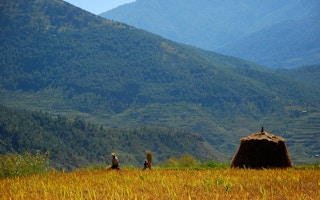If 2018 was the year of the global heatwave, then 2019 looks set to bring even more extreme weather with early indications of an El Niño event in the next three months.
And while high temperatures last year brought food and water shortages, the phenomenon of El Niño comes with the threat of hotter and more extreme weather events, with potentially dramatic effects on agriculture and food production worldwide.
The likely impact – from unpredictable rainfall to prolonged droughts - will hit smallholder farmers in developing countries hardest unless they are supported to adapt and build greater resilience to this changing climate.
Fortunately, through existing innovations and new technologies, we can help ensure richer, timely data is at farmers’ fingertips to help them better anticipate and prepare for El Niño and the effects of climate change on agriculture and on their livelihoods.
With growing levels of digitalisation, smallholders can learn to use inputs and environmental resources more efficiently to become climate-smart farmers.
One of CTA’s projects, for example, links farmers in South Africa with government extension and weather services along with research groups and private sector to help improve their resilience to climate change.
By specifically prioritising access to IT-based forecasting systems and associated weather-based insurance schemes, the initiative sets out to improve productivity and adaptation for 140,000 smallholders over two years.
Such crucial and context-specific information about weather conditions and agronomic advice helps farmers increase their yields with precise instructions based on localised weather patterns, and this will become invaluable with more expected extreme weather this year.
Meanwhile, access to reliable weather data has also unlocked greater access to loans, insurance and other financial services, as climate-smart farmers are seen as a less risky investment by banks.
This in turn has helped farmers build more resilient livelihoods and predictable incomes in the face of unpredictable weather because they are better equipped to invest in their businesses. Climate-smart farmers who are able to take out loans are then able to invest in ever more sustainable production tools and methods to help them mitigate climatic shocks.
“
By specifically prioritising access to IT-based forecasting systems and associated weather-based insurance schemes, the initiative sets out to improve productivity and adaptation for 140,000 smallholders over two years.
Elsewhere, Kenyan agribusiness, UjuziKilimo, uses wireless sensor networks to monitor soils and provide advice on fertilizers, seeds, weather and best practices to help smallholders farm with greater precision, according to local conditions and climate.
And Hello Tractor, a Nigerian start-up, provides farmers with smart tractors, equipped with GPS and telematic technology, which enables data collection on the farm’s location and size, and planting and harvesting times.
This data, combined with other information on weather conditions and soil type, can serve as an early warning system for environmental changes to allow farmers to respond swiftly and reduce the risk of crop losses.
Some of these innovations are among those to have emerged through CTA’s Agri-Hack Talent initiative, which encourages young people to harness the power of mobile phones, social media and web-based platforms to reboot agriculture.
Drones are another example of a new technology that is increasingly becoming a valuable tool for farmers, helping them monitor their crops for diseases and pests that are spreading in unexpected ways because of climate change.
CTA’s Eyes in the Sky project provides crop inventory and crop management advice to smallholder farmers that helps them offset the risks of an increasingly unpredictable climate.
Connecting farmers to such expert advice has helped them to calculate yields as well as their fertiliser and seed requirements.
And by creating digitalised profiles of more than 4,000 smallholder farmers, which map the location, size and productivity of their farms through a simple platform, the project has helped provide up-to-date agronomic advice.
Climate shocks in any year can have a devastating impact on food security, particularly in already vulnerable regions, and El Niño is likely to bring prolonged consequences.
New technologies can lessen the sting of surprise through better forecasting – whether that’s weather, crop disease or yields – allowing farmers a better chance of working with their new conditions than against them.
Michael Hailu is the director of the Technical Centre for Agricultural and Rural Cooperation. This story was published with permission from Thomson Reuters Foundation, the charitable arm of Thomson Reuters, that covers humanitarian news, climate change, resilience, women’s rights, trafficking and property rights. Visit http://news.trust.org/climate.









